The Kinetrol rotary vane design is based upon a single moving part which eliminates additional parts required to convert linear motion to rotary motion. This simple and innovative design provides a highly accurate and extremely reliable actuator for operating valves, drives and dampers, and is perfectly suited for the most demanding process control applications. For more information visit www.kinetrolusa.com or call 972-447-9443.
Why Do Kinetrol Actuators Last So Long?
Kinetrol actuators are known world-wide for their extremely long service life, even in harsh environments. Here are a few reasons why.
KintrolUSA.com
972-447-9443
Kinetrol Actuators Protect People and Property with Reliable Performance in Chemical Plant Fire
 |
| The Kinetrol actuator is completely unrecognizable, having been melted in a fire. |
The building houses a $30 million dollar compressor that supplies process air to reactors to begin the PTA manufacturing process.
As part of the safety system, (2) two 6" class 150 high performance butterfly valves with Kinetrol 097-120 and open/closed limit switches were installed on process air lines of one production unit.
During the fire, the two Kinetrol actuated valve assemblies performed exactly as required, shutting the valves tightly and keeping them shut even after the heat of the fire completely melted the actuator housings.
 |
| Closer view. |
For more information, contact Kinetrol USA by calling 972-447-9443 or by visiting https://kinetrolusa.com.
Valve Failure Modes
 |
| Failsafe spring lever on ball valve. (Kinetrol) |
Available Failure Modes
Valve fail mode may be shown in instrument diagrams by either an arrow pointing in the direction of failure (assuming a direct-acting valve body where stem motion toward the body closes and stem motion away from the body opens the valve trim) and/or the abbreviations “FC” (fail closed) and “FO” (fail open). Other failure modes are possible, as indicated by this set of valve symbols:
In order for a pneumatic or hydraulic valve to fail in the locked state, an external device must trap fluid pressure in the actuator’s diaphragm or piston chamber in the event of supply pressure loss.
Valves that fail in place and drift in a particular direction are usually actuated by double-acting pneumatic piston actuators. These actuators do not use a spring to provide a definite fail mode, but rather use air pressure both to open and to close the valve. In the event of an air pressure loss, the actuator will neither be able to open nor close the valve, and so it will tend to remain in position. If the valve is of the globe design with unbalanced trim, forces exerted on the valve plug will move it in one direction (causing drift).
Reprinted from "Lessons In Industrial Instrumentation" by Tony R. Kuphaldt – under the terms and conditions of the Creative Commons Attribution 4.0 International Public License.
Upper Midwest Water Treatment Plant says "Out with the old, in with the new!"
 |
| Before project. |
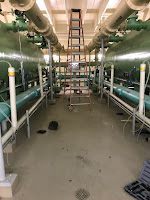 |
| Project begins. |
An Upper Midwest water treatment plant was experiencing high failure rates, long maintenance periods, and too many repair issues with their existing pneumatic scotch-yoke cylinder valve operators.
Upon investigation, the problem boiled down to how the scotch-yoke cylinder's linear movement is converted to rotational movement. To do so requires gearing, yokes and linkage which are wear points. In medium to high cycle rate applications these wear points soon become failure points.
Kinetrol rotary vane actuators utilize a single moving part - the one-piece vane and shaft. There are no gears, yokes, or linkages and 100% of the movement is transferred to the actuator shaft. The one piece vane and shaft eliminates these wear points, and therefore eliminates the resulting failure points.
 |
| Out with the old. |
 |
| In with the new. |
After a planning review meeting, this particular water treatment plant clearly saw the advantages of the Kinetrol design. The argument was so strong and the case so clear, they decided to replace all (60) scotch-yoke cylinder actuated valves with Kinetrol vane actuators in one fell swoop.
The new actuators have been operating for 6 months now without problem, cycling approximately 15 times per day.
Click on the images above to see a larger view. For more information, contact Kinetrol USA by visiting https://kinetrolusa.com or by calling 972-447-9443
The Kinetrol Actuator Vane Assembly Design
The Kinetrol rotary vane actuator utilizes an advanced design vane assembly that is engineered to provide millions of trouble-free cycles. This video highlights the advanced features that make it the most reliable 1/4 turn pneumatic actuator on the market today.
https://kinetrolusa.com
972-447-9443
972-447-9443
Kinetrol Actuators Stand Up to Tough Iron Foundry Environment and Very High Cycle Rate
 |
| Kinetrol on high cycle valve. |
The rack and pinion actuator was replaced with a Kinetrol vane actuator and the customer's problem disappeared. The Kinetrol actuators have performed for over 2 years now without problem.
Click on any of the pictures for a larger view.
Kinetrol Actuator "Insures" Rapid Valve Closing to Protect Equipment, Infrastructure, and Personnel
 |
| 20" high performance butterfly valve with Kinetrol actuator |
Requirement:
It's necessary to prevent a $30M USD axial process air compressor from rapidly going into an overspeed condition that could harm equipment, infrastructure, and personnel.
Challenge:
 The biggest challenges: stroking the valve in under one second, but without slamming the butterfly disc into the stops which can damage the valve and nearby equipment.
The biggest challenges: stroking the valve in under one second, but without slamming the butterfly disc into the stops which can damage the valve and nearby equipment.
Solution:
Kinetrol's expertise in rapid cycling enabled us to size, select, and perform certified cycle time tests on the final assembly. This shut out any competition.
Assembly:
20" class 300 high performance butterfly valve, Kinetrol 207-120 with a 2" automatic L-Port, 3-way, compressed air supply ball valve with 097-F120, X-proof solenoid, and two exhaust silencers coupled to the size 20 supply port. Open / closed limit switch assembly. Robust SST mounting bracket and coupling. The closure time once actuator air is exhausted: 0.13 seconds.
Kinetrol Blueline Actuator for Use in Foodservice and Beverage Processing
Kinetrol's "Blueline" Series of pneumatic vane actuators for use in foodservice and beverage processing. The actuators are intended to be installed in areas where harsh chemical wash-down is required. These areas are very tough on most types of pneumatic actuators because the caustic or acidic chemicals used in cleaning adversely effect the actuator. Kinetrol's Blueline Series provides a very economical option these areas.
Challenging Steam Balancing Valve Application at Southwest Power Plant
 |
| Steam balance valve with Kinetrol model 30. |
Outfitting these valves with pneumatic actuators is also difficult. Because of the valve size and valve design, actuators must have high torque output, without taking up vast amounts of space. The actuators must also act quickly and eliminate hysteresis.
Most pneumatic actuator designs simply cannot meet the operating and size restrictions, and hydraulic actuators, with all of their associated maintenance problems, are used instead.
A Kinetrol Distributor in the Southwest USA was asked to recommend a better alternative to a line where very large scotch-yoke actuators controlling two (2) 18" valves were controlling poorly and were taking up too much space.
The Distributor's challenge was to:
- Deliver very high torque output.
- Provide as small a package as possible.
- Improve the actuators stability and reliability.
 |
| Power plant steam balancing valves in service. |
For more information, contact Kinetrol USA by visiting https://kinetrolusa.com or by calling 972-447-9443.
New EL Positioner Installation Video from Kinetrol USA
The video below is new from Kinetrol USA and provides detailed instructions on how to install a Kinetrol model EL electro-pneumatic positioner.
The EL positioner controls airflow to an actuator and moves it to a position determined by a 4-20mA signal and using a unique low power proportional servo valve. The combination of EL positioner and Kinetrol vane actuator provide fast, smooth and precise control for industrial valves and dampers.
The EL positioner controls airflow to an actuator and moves it to a position determined by a 4-20mA signal and using a unique low power proportional servo valve. The combination of EL positioner and Kinetrol vane actuator provide fast, smooth and precise control for industrial valves and dampers.
https://kinetrolusa.com
972-447-9443
972-447-9443
A Review: Why Kinetrol Actuators Are the Most Reliable 1/4 Turn Pneumatic Actuator on the Market Today
With millions of actuators performing reliably around the world, the Kinetrol vane actuator's are the best choice for valve and damper actuation applications that require long life and ultra-dependable performance. Here's a review as to why:
 |
| Click on image for larger view. |
- Durable epoxy stove enamel exterior finish.
- Long life epoxy or PTFE internal finish.
- Integral vane/shaft casting - only one moving part: Simplest and most reliable mechanism for quarter-turn rotary actuation.
- Manual override square and position indicator.
- Stainless steel expanders ensure long term lipseal / case contact.
- Double opposed, Polyurethane, lip seals for effective sealing and long maintenance free life.
- Space filling/energy absorbent sideplates (polymer or metal).
- Corrosion resistant zinc (non-incendive) or aluminum alloy case.
- Easy stop adjustment at each end of stroke for accurate seating.
- Close couple control modules. Fail-safe spring returns, limit switches, positioners and solenoid valves all close couple to the actuators.
- No cranks or gearing. No power loss or backlash - allows accurate positioning.
- Long maintenance-free life. Up to 4 million operations guaranteed.
- Compact - space saving - efficient. Best torque/size package available, fast operating speeds, best air consumption, proven design.
- Unique serial number for identification and traceability.
For more information, visit https://kinetrolusa.com of call 972-447-9443.
Innovative Gate Opening System Driven by Kinetrol Actuators
The customer is a foundry located in the mid-West. Safe access over a conveyor is required over a ramp to allow personnel to come and go as needed. A pneumatic gate and ramp system needed to be designed that would simultaneously open and close two (2) steel gates. The opening and closing would be controlled by a simple hand-switch on the ramp railing.
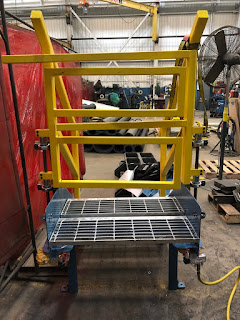 |
| View of ramp and gates. |
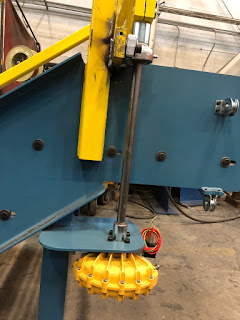 |
| Side view of Kinetrol actuator and drive shaft. |
Two Kinetrol vane actuators are mounted under and on each side of the ramp. Driveshafts connected to the Kinetrol actuators open and close the steel gates. Solenoid valves respond to the hand-switch to pilot the actuators.
For more information, contact Kinetrol USA by visiting https://kinetrolusa.com or by calling 972-447-9443.
Kinetrol Vane Actuators: Performance Under Pressure
Here is a short video of Kinetrol valve actuators installed in power plant, chemical plant, cement plant, water treatment, and primary metal plant applications.
972-447-9443
The Most Reliable 1/4 Turn Pneumatic Actuator on the Market Today. Period.
With millions of actuators performing reliably around the world, the Kinetrol vane actuator's outstanding cycle life, smooth and precise movement, and environmentally rugged design makes it the best choice for all of your valve actuation needs.
Kinetrol Vane Actuator Outperforms Rack and Pinion on Power Plant Filter-Demineralizer System
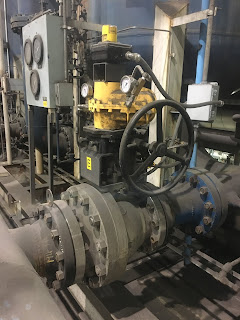 |
| Kinetrol Vane Actuator on Power Plant Filter-Demineralizer System |
At one midwest power utility company, a valve controlling the flow of water (210 psi and 140 deg. F) that feeds the demineralizer was causing concern. The valve's accompanying rack and pinion actuator was creating a maintenance problem. While this isn't a high cycle application, the system must be 100% reliable, and the old actuator's performance was unreliable. The solution was to install a Kinetrol vane actuator. A new automated valve was installed 6 years ago (2012) and the Kinetrol actuator has operated flawlessly since then.
Cement Hopper Valve Actuator Requires Kinetrol's Accuracy, Dependability and Toughness
 |
| Location of the actuator and valve at bottom of hopper. |
No only did this approach require a human operator (with associated costs and safety precautions) to be present, the manual system didn't provide the degree of control the company needed. Careful control of the cement into the truck is important because uncontrolled flow, or too rapid a flow, will overwhelm the dust collection system and allow fugitive emissions (dust) to escape to the atmosphere. A serious regulatory and safety issue.
 |
| Kinetrol actuators and positioners perform in dirt and dust. |
For more information, contact Kinetrol USA by visiting https://kinetrolusa.com or by calling 972-447-9443.
Power Plant Bearing Cooling Water Temperature Control
A midwest power plant was using a diaphragm control valve to control water temperature for their bearing cooling system. The closed-loop bearing cooling system uses the modulating valve to control water temperature between 50 and 170 degrees F. at 170 PSIG. The diaphragm valve was not able to provide the required signal response for tight control.
The local Kinetrol Distributor specified a high performance butterfly valve (HPBV) with Kinetrol spring return actuator and third-party positioner. The new valve and actuator package provided reliable and accurate controllability with zero hysteresis. It has operated continually for 3 years without maintenance.
The local Kinetrol Distributor specified a high performance butterfly valve (HPBV) with Kinetrol spring return actuator and third-party positioner. The new valve and actuator package provided reliable and accurate controllability with zero hysteresis. It has operated continually for 3 years without maintenance.
 |
| Bearing Cooling Water Temperature Control Valve |
Kinetrol Actuators on Power Plant Descaling Water System
 |
| Kinetrol actuator on descale water system. |
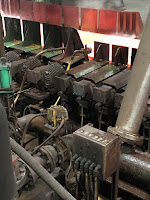 |
| Wider view. |
The local Kinetrol Distributor recommended switching to a high performance butterfly valve (HPBV) and Kinetrol double acting actuator as the replacement. These actuators and valves are installed in a very dirty area (see picture), and during power generation, are exposed to high heat and are cycled every 30 seconds. The first installation has been in place for 20 months and operating without problem. Now, as each knifegate comes up for maintenance, they are being replaced with the Kinetrol operated butterfly valve.
For more information, contact Kinetrol USA by visiting https://kinetrolusa.com or calling 972-447-9443.
Pneumatic Valve and Damper Actuators: A Design Comparison
 Industrial valves, dampers and louvers are operated either electrically or pneumatically. This post compares the three major categories of pneumatic valve actuators, namely:
Industrial valves, dampers and louvers are operated either electrically or pneumatically. This post compares the three major categories of pneumatic valve actuators, namely:- Rotary vane
- Scotch-yoke
- Rack & pinion
All three can be configured in either direct acting or spring return versions. Direct acting actuators use the air supply to move the actuator in both directions (open and close). Spring return actuators, as the name implies, uses springs to move the actuator back to its "resting" state. Converting from direct acting to spring return is done through simple modifications, typically just adding an external spring module, or removing the end caps from rack and pinion actuators and installing several coil springs.
 |
| Rotary Vane Actuator |
Rotary Vane Actuators
Vane actuators generally provide the most space savings when comparing size-to-torque with rack and pinion and scotch yoke. They have an outstanding reputation for long life because then contain only one moving part, as opposed to rack and pinion and scotch yoke actuators that have many. They tend to withstand dirty and corrosive atmospheres better than rack and pinion and scotch yoke actuators. Vane actuators also use externally mounted, helically wound "clock springs" for their spring return mechanism.
 Scotch Yoke
Scotch Yoke
Scotch-yoke actuators use a pneumatic piston mechanism to transfer movement to a linear push rod, that in turn engages a pivoting lever arm to provide rotation. They come in a wide variety of sizes, but are very often used on larger valves because they are capable of producing very high torque output. Spring return units have a large return spring module mounted on the opposite end of the piston mechanism working directly against the pressurized cylinder.Rack and Pinion
 A rack & pinion pneumatic actuator uses opposing pistons with integral gears to engage a pinion gear shaft to produce rotation. Rack & pinion actuators (sometimes referred to as a lunch box because of their shape) tend to be more compact than scotch yoke, have standardized mounting patterns, and produce output torques suitable for small to medium sized valves. They almost always include standard bolting and coupling patterns to directly attach a valve, solenoid, limit switch or positioner. Rack and pinion actuators use several smaller coil springs mounted internally and provide the torque to return the valve to its starting position.
A rack & pinion pneumatic actuator uses opposing pistons with integral gears to engage a pinion gear shaft to produce rotation. Rack & pinion actuators (sometimes referred to as a lunch box because of their shape) tend to be more compact than scotch yoke, have standardized mounting patterns, and produce output torques suitable for small to medium sized valves. They almost always include standard bolting and coupling patterns to directly attach a valve, solenoid, limit switch or positioner. Rack and pinion actuators use several smaller coil springs mounted internally and provide the torque to return the valve to its starting position.The practical difference between these three types of pneumatic actuators comes down to size, power, torque curve and ease of adding peripherals. For the best selection of valve actuator for any quarter turn valve application, you should seek the advice of a qualified valve automation specialist. By doing so your valve actuation package will be optimized for safety, longevity, and performance.
Scotch yoke mechanism image courtesy of Wikipedia.
Rack and pinion mechanism image courtesy of Wikipedia.
Labels:
actuator,
pneumatic,
rack and pinion,
Rotary vane actuator,
scotch yoke
Updated Kinetrol Rotary Actuator Catalog - March 2018
Here is the March 2018 edition of the Kinetrol Rotary Actuator Catalog. You may view it in the embedded viewer below, or download it from this link.
Kinetrol Blueline Actuator Stands Up to Harsh Conditions in Cheese Factory
 A very large mozzarella cheese producer in the USA had an actuator problem with their EFV’s (Enclosed Finishing Vats). The flow of the curds being blown into the EFV’s is controlled by star valves and pneumatic actuators. The actuators and valves serve (2) critical purposes: 1) The shut off of the star valve; and 2) controlling the air flow of the blower.
A very large mozzarella cheese producer in the USA had an actuator problem with their EFV’s (Enclosed Finishing Vats). The flow of the curds being blown into the EFV’s is controlled by star valves and pneumatic actuators. The actuators and valves serve (2) critical purposes: 1) The shut off of the star valve; and 2) controlling the air flow of the blower.The cheese plant had continuous service problems with their existing actuators. Some had to be replaced within one week of installation. Failure of the actuators caused the curd line to be plugged, and when replacement of the actuator was needed, it would result in a huge mess to be cleaned up off of the production floor. With a 24/7 production timetable, a solution needed to be found to keep the EFV’s up and running.
Kinetrol Blueline vane actuators were recommended because of their 4 million operation guarantee and the new proprietary coating that meets FDA specifications and is permitted for use in food service.
The Kinetrol Blueline actuators eliminated the maintenance issues completely and the Blueline coating has held up excellently after caustic wash-down, with no signs of degradation or fading.
https://kinetrolusa.com
972-447-9443
Words Used to Describe Kinetrol Actuators
The Most Reliable 1/4 Turn Pneumatic Actuator on the Market Today. Period.
For over 50 years Kinetrol has been providing trouble-free valve and damper actuators to the chemical, biofuel, food & beverage, metal, mineral, oil, gas, pharmaceutical, power generation, paper, textile, water, wastewater, and transportation industries.https://kinetrolusa.com
972-447-9443
The Advantages of Torsion Springs for Pneumatic Actuators
 |
| Kinetrol uses a torsion spring as the motive force for their actuator spring return. |
Torsion (clock) springs posses a natural tendency to expand, producing a cumulative torque that increases as the spring is wound tighter. Both ends of the torsion spring are attached to other, separate components. When one component rotates around the center point of the spring, the spring will increasingly try to return to the original state. When a torque is applied to a spiral torsion spring, an angular displacement is created between the first and second loading points. The coil then deflects (tightens), and the spring material is placed under stress, which in turn exerts a linear rotational "output" torque.
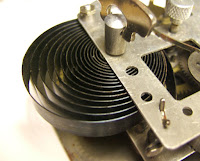 |
| An internal view of the clock spring. You'll note similarities with the Kinetrol spring return unit. |
Practically speaking, spiral torsion springs allow for lower torque loss, lower torque stress, and much greater reliability for use in valve and damper actuation.
Advantages of the torsion spring:
- High torque delivery per unit of deflection
- Low cost
- Compact
- Reliable
- Adjustable
Epoxy Stove Enamel Finish: A Kinetrol Advantage
Kinetrol actuators are well-known for their bright yellow, epoxy stove enamel finish. This coating is engineered to protect the exterior of their pneumatic actuators and accessories. But what is "epoxy stove enamel"?
Epoxy stove enamel is a high quality stoving finish that provides excellent adhesion to a substrate. Epoxy stove enamel forms a very hard, abrasion resistant, chemical and solvent resistant coating that stands up to many extreme environmental conditions. Epoxy stove enamel finish provides high level chemical/corrosion resistant qualities, and is used often in applications such as machinery, industrial equipment, and heavy duty transport machinery.
Kinetrol actuators are engineered specifically for high-cycle, dirty, and corrosive applications. The combination of epoxy stove enamel finish and stainless steel external hardware provide Kinetrol actuators outstanding protection from dirt and harmful chemicals.
Kinetrol USA
https://kinetrolusa.com
972-447-9443
Epoxy stove enamel is a high quality stoving finish that provides excellent adhesion to a substrate. Epoxy stove enamel forms a very hard, abrasion resistant, chemical and solvent resistant coating that stands up to many extreme environmental conditions. Epoxy stove enamel finish provides high level chemical/corrosion resistant qualities, and is used often in applications such as machinery, industrial equipment, and heavy duty transport machinery.
Kinetrol actuators are engineered specifically for high-cycle, dirty, and corrosive applications. The combination of epoxy stove enamel finish and stainless steel external hardware provide Kinetrol actuators outstanding protection from dirt and harmful chemicals.
Kinetrol USA
https://kinetrolusa.com
972-447-9443
Who makes the most reliable industrial valve actuator?
With millions of actuators performing reliably around the world, the Kinetrol vane actuator's outstanding cycle life, smooth and precise movement, and environmentally rugged design makes it the best choice for all of your valve actuation needs.
https://kinetrolusa.com
https://kinetrolusa.com
Consider Space and Fit as a Cost Driver When Applying Actuation to Your Valves and Dampers
Being creative with the design and layout of automated valve packages, and paying attention to space, has significant impact on the total life-cost of an automated valve (or damper) package. Evaluating the footprint available, and then choosing components that will allow for simple installation and continued ease of maintenance, will pay dividends over the long term. Always plan your valve and damper automation systems with ample space for access to tools and service personnel. Don't burden your maintenance staff with an over complicated or nightmarish actuation system that takes hours of preparation just to do routine maintenance. Also consider that easier access many times means greater safety.
Kinetrol pneumatic actuators, spring modules, and positioners are engineered with this in mind. Their efficient actuator design provides more torque in a smaller package and their bolt together, modular configuration, provides very significant space savings. The result is more power in a smaller space, along with easy access, and quick change-out.
As you can see from the image above, electrohydraulically powered valves and dampers (left) require pumps and motors. Pneumatic cylinder operated valve and dampers require mounting fixtures, linkages, and additional tubing. But you'll note the Kinetrol actuator and positioner (center) provides mounting directly to the valve/damper shaft. The automation is done cleanly and takes up substantially less space.
Which would you rather service?
Kinetrol pneumatic actuators, spring modules, and positioners are engineered with this in mind. Their efficient actuator design provides more torque in a smaller package and their bolt together, modular configuration, provides very significant space savings. The result is more power in a smaller space, along with easy access, and quick change-out.
 |
| Consider Space When Applying Actuation (click for larger view) |
As you can see from the image above, electrohydraulically powered valves and dampers (left) require pumps and motors. Pneumatic cylinder operated valve and dampers require mounting fixtures, linkages, and additional tubing. But you'll note the Kinetrol actuator and positioner (center) provides mounting directly to the valve/damper shaft. The automation is done cleanly and takes up substantially less space.
Which would you rather service?
Pneumatic Valve and Damper Actuators Designed to Stand Up to the Cement Industry
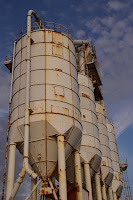 |
| Cement silos. |
Because of their reliability and ruggedness, Kinetrol rotary vane actuators are used in many processes across a cement plant. These applications include vehicle unloading, silo discharge, air cooling dampers, distribution, bagging and emissions control.
You can download a PDF that outlines where vane actuators are used in all areas of cement production here, or you can read the embedded document below.
Industrial Valve Actuator Types
 |
| Lever actuator (with failsafe spring return) |
Manual
Manual actuators are capable of placing the valve in any position but do not permit automatic operation. The most common type mechanical actuator is the handwheel. This type includes handwheels fixed to the stem and handwheels connected to the stem through gears.
Electric Motor Actuators
 |
| Gear operator (attached to pneumatic actuator) |
Electric motors permit manual, semi-automatic, and automatic operation of the valve. Motors are used mostly for open-close functions, although they are adaptable to positioning the valve to any point opening. The motor is usually a, reversible, high speed type connected through a gear train to reduce the motor speed and thereby increase the torque at the stem. Direction of motor rotation determines direction of disk motion. The electrical actuation can be semi-automatic, as when the motor is started by a control system. A handwheel, which can be engaged to the gear train, provides for manual operating of the valve. Limit switches are normally provided to stop the motor automatically at full open and full closed valve positions. Limit switches are operated either physically by position of the valve or torsionally by torque of the motor.
Pneumatic Actuators
 |
| Pneumatic actuator |
Hydraulic Actuators
Hydraulic actuators provide for semi-automatic or automatic positioning of the valve, similar to the pneumatic actuators. These actuators use a piston to convert a signal pressure into valve stem motion. Hydraulic fluid is fed to either side of the piston while the other side is drained or bled. Water or oil is used as the hydraulic fluid. Solenoid valves are typically used for automatic control of the hydraulic fluid to direct either opening or closing of the valve. Manual valves can also be used for controlling the hydraulic fluid; thus providing semi-automatic operation.
Solenoid Actuated Valves
 |
| Solenoid valve (attached to pneumatic actuator) |
Single solenoid valves are termed fail open or fail closed depending on the position of the valve with the solenoid de-energized. Fail open solenoid valves are opened by spring pressure and closed by energizing the solenoid. Fail closed solenoid valves are closed by spring pressure and opened by energizing the solenoid. Double solenoid valves typically fail "as is." That is, the valve position does not change when both solenoids are de-energized.
One application of solenoid valves is in air systems such as those used to supply air to pneumatic valve actuators. The solenoid valves are used to control the air supply to the pneumatic actuator and thus the position of the pneumatic actuated valve.
Contact Kinetrol USA for any valve actuation challenge. They can be reached at https://kinetrolusa.com or by calling 972-447-9443.
Pneumatic Valve Actuator Assembly Designed to Prevent Water Hammer
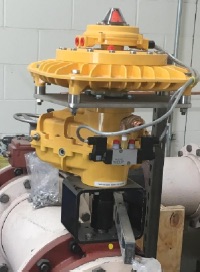 |
| Kinetrol vane actuator and dashpot assembly |
The "hammering" is due to a pressure wave created by the instantaneous change in fluid velocity when a valve is suddenly closed or opened. Controlling valve closure time is one of the most economical ways to minimize water hammer. To do this efficiently, while still meeting the process requirements, the use of a variable speed mechanism to control valve stroke is used. One unique, economical and space savings approach is to use a pneumatic vane actuator coupled with a rotary damper (or dashpot).
Rotary dashpots are precision fluid damping devices which give a smooth resistance to shaft rotation which increases with angular velocity.
In this case, a pump station in the USA was having repeated problems with a large, open reservoir hydraulic actuator used to dampen valve opening and closing. It was overly cumbersome and costly to maintain.
 In its place, the pumping station installed Kinetrol Size 14 double acting actuators with digital speed controllers and Kinetrol LJ rotary dampers (with through-shafts to facilitate position feedback) installed on 12” Pratt butterfly valves.
In its place, the pumping station installed Kinetrol Size 14 double acting actuators with digital speed controllers and Kinetrol LJ rotary dampers (with through-shafts to facilitate position feedback) installed on 12” Pratt butterfly valves.The addition of the bi-directional, sealed dashpots smooth the normal travel, damp any valve flow induced disc oscillations, and provide at least 40 seconds travel time on air and/or electrical power failure.
Using pulsed outputs with programmable delay between steps, the actuators provide a 10 minute opening & closing time for the full 90 degree travel. The system is adjustable between 3-15 minutes with less than one degree increments., and other opening and closing ranges are available. The actuators use fail-free logic, but fail-hold & fail-safe are available.
These assemblies were commissioned in early Fall of 2017 and are working very well. Their use will be replicated at other pump stations operated by the same customer.
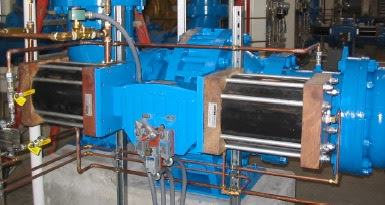 |
| This open reservoir hydraulic actuator was huge and a maintenance headache. |
Corrosive Flow Control Requirement? Use Thermoplastic Valves and Corrosion Resistant Rotary Actuators
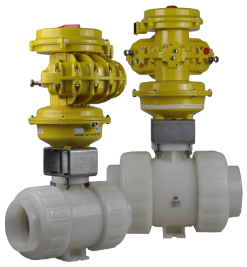 |
| Thermoplastic valves with corrosion resistant actuators, springs and positioners. (Kinetrol) |
Thoughtful actuator selection is required when plastic valves are specified. While the mechanics in applying pneumatic actuators to plastic quarter-turn valves is no different than metallic valves, the characteristics of the process and application can have significant impact on the performance the automated valve.
The assumption is that, if a thermoplastic valve is required, there is an higher probability the of exposure to corrosive media, or the automated valve assembly is located in a corrosive atmosphere, and therefore a corrosion resistant pneumatic actuator is preferred. Considering this, an actuator with internal and external parts protected by epoxy resins or special paints should be applied. Additionally, actuator spring systems should be designed in way to prevent exposure to corrosive media.
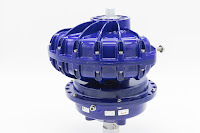 |
| Corrosion resistant rotary vane actuator with special external coating. (Kinetrol Blueline). |
The rotary vane actuators manufactured by Kinetrol standardly meet theses requirements. Engineered specifically for high-cycle, dirty, and corrosive applications, these very hardy, compact actuators come standardly with an epoxy stove enamel finish, stainless steel internal and external hardware, with spring units that are totally sealed from the atmospheric contaminants. For applications requiring greater corrosion resistance, such as caustic wash-down or salt-laden environments, an optional "Blueline" coating can be applied,
Subscribe to:
Posts (Atom)











